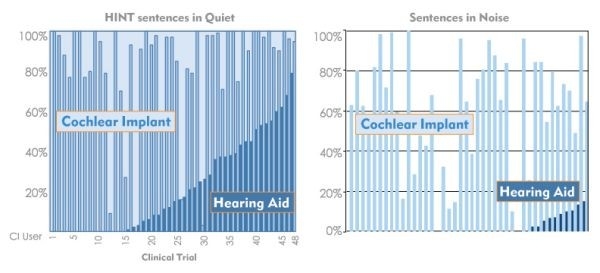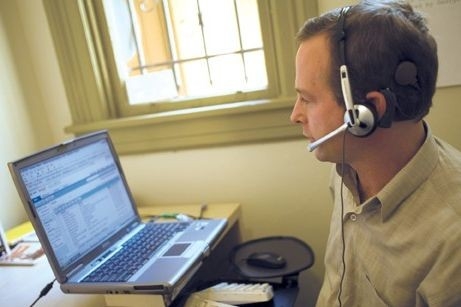
Frequently Asked Questions
Choosing the journey to hearing with a cochlear implant is one of the most important decisions you’ll ever make for yourself or your child. These answers to frequently asked questions are designed to help you make the right decision and get the most out of your journey.
If you don’t find the answers to your questions, you’re invited to contact AB directly.
AB Provides Lifelong Service and Support
“Everyone we have come into contact with at AB has been nothing less than wonderful. They really care about you and your experiences and are ready to answer any questions that come up. They listen to your concerns and really make you feel like you’re not alone and that your feedback matters.”
— Lisa Cunningham, mother of Liliana, bilaterally implanted by age 13 months
Cochlear implants may be a much more effective alternative to hearing aids for adults and children with severe-to-profound greater hearing loss. Unlike hearing aids, which amplify sound, cochlear implants are electronic devices that bypass the damaged part of your inner ear so that you can hear your best.
A cochlear implant system consists of two main components. The external component, which is worn on the outer ear or discreetly on the body, and the internal component, the implant, which delivers sound to the hearing nerve.
Hearing aids are designed to amplify sound, but often this is not enough to make it any clearer or easier to understand for people with severe-to-profound hearing loss. Cochlear implants bypass the damaged part of the ear, sending sound directly to the hearing nerve, where it’s relayed on to the brain. Most cochlear implant recipients demonstrate improvement in their ability to understand speech, even in noisy environments, compared to hearing-aid wearers.

The most commonly recommended treatment for hearing loss is a hearing aid. A hearing aid amplifies sound or, more simply, makes sound louder. By amplifying sound, any remaining, healthy sensory cells in the ear are stimulated to transmit sound information to the auditory nerve and brain. Making sound louder cannot always overcome the damage to or loss of sensory cells in the inner ear, which means that sounds and speech may not be understood or even detected at all with powerful hearing aids. In these cases, cochlear implants can be a much more effective solution for adults and children with severe-to-profound hearing loss.
If your child failed a newborn hearing screening test or still struggles to hear with hearing aids, they may be a candidate for cochlear implants. Take the candidacy quiz and consult with your hearing healthcare professional to determine whether cochlear implants are the right choice to treat your child’s hearing loss.
If you are struggling to hear with hearing aids, you may be a candidate for cochlear implants. Take the candidacy quiz and consult with your hearing healthcare professional to determine whether cochlear implants are the right choice to treat your hearing loss.
Young children can be implanted as young as 12 months of age, depending on their health, the cause of their hearing loss, and other factors. Early implantation provides your child access to hearing voices and speech, which is critical in developing strong language and speech skills.
Take the candidacy quiz and consult with your hearing healthcare professional to determine whether cochlear implants are the right choice to treat your child’s hearing loss.
Financing options and insurance coverage vary by region. Contact the AB office in your area to learn more.
If you are getting only one cochlear implant, there are several factors to consider in deciding which ear to implant. Some prefer to implant their poorer-hearing ear so they can use a hearing aid in their better-hearing ear. Others decide to implant their better-hearing ear, hoping for a better result. Other factors come into play as well, including surgical considerations of each ear’s anatomy, length of deafness in each ear, even general preference. Your cochlear implant team will provide you with their recommendations based on your specific case. If both ears have an equal chance of success, you may have the ultimate say in choosing which ear to implant.
Depending on candidacy and healthcare coverage, people with hearing loss sometimes get both ears implanted at the same time. This is called “simultaneous implantation,” and it’s done to achieve bilateral hearing (hearing in both ears). Others opt for a second implant at a later date (sequential implantation), after first experiencing life with only one implant for a while.
Bilateral hearing is the way normal hearing works and offers several advantages over unilateral hearing (hearing with one ear), including better sound localization (the ability to better locate the direction from which sound is coming) and improved hearing in noisy environments.1
You or your child may continue to wear a hearing aid in the non-implanted ear. Continuing to use your hearing aid in one ear and a cochlear implant in the other ear may help you to hear better in noisy environments, as well as assist in localizing sound. This solution, known as bimodal hearing, can be substantially beneficial. Talk to your hearing health professional about using both technologies for optimum hearing performance.
Every person’s journey to hearing is as unique as the details of every person’s hearing loss. Your or your child’s hearing experience with cochlear implants is dependent upon a number of biological factors, including:
- Age when hearing loss began
- Length of hearing loss
- Age at implantation
- The medical health of the inner ear
- Other medical conditions that could affect hearing
It’s important to understand that better hearing through a cochlear implant is a process, not an instant fix. Just as those with normal hearing had to learn to hear as children, so too must you or your child learn to hear again – with a cochlear implant. Cochlear implant recipients should expect to make continual progress. How much progress and how rapidly you progress depends on three factors: (1) the technology used, (2) individual biology, and (3) the education and practice after implantation.
Advanced Bionics uses the most cutting-edge technology and offers comprehensive support and education to help you or your child get the very most out of the journey to hearing.
AB’s HiRes Fidelity 120™ sound processing is the only sound processing strategy that can implement simultaneous current steering to deliver the dimensions of music (loudness, pitch, timing) for a full musical experience. AutoSound™s programmable wide Input Dynamic Range (IDR) and automatic volume control adjust automatically so that you don’t miss a note. And, the naturally placed T-Mic™ microphone makes it effortless to use your MP3 player. This advanced technology only from AB works in concert so that you hear your best.
The cochlear implant system you decide to go with is an important, lifelong decision that will affect every step of your or your child’s journey to hearing. Only AB offers the industry’s most advanced technology designed to deliver better hearing performance in the challenging listening environments encountered throughout the day. When you choose an Advanced Bionics cochlear implant system, you or your child will benefit from AB’s unique advantages:
- The most sophisticated, cutting-edge technology to help you hear your best in real-world conditions, including in noise, hearing speech, and listening to music.
- Industry-leading total system reliability to keep you hearing day in and day out, with a minimum of downtime.
- Flexible wearing options and a full line of accessories that allow you to wear and customize your sound processor in the way that best suits your lifestyle.
- Continued support and educational resources from AB, your lifetime partner, on your entire journey to hearing.
- AB partnership with Phonak, a world leader in hearing instruments, that aims to deliver more technological innovations that continue to improve your or your child’s hearing.
The ideal solution for children, AB’s cochlear implant system is designed to be intuitive and kid-friendly.
- Flexible wearing options that adapt to your child’s needs from infancy to adulthood
- Advanced water protection that’s guaranteed
- Fully programmable childproof controls that are easy to see and use
- Environmentally friendly, “green” battery options that are easy to change, rechargeable, cost effective, and available in two sizes
- IntellilinkTM safety feature that sends information only to your child’s implants, preventing swapping between users and bilateral mismatches
- Accessories like the Kinder ClipTM and SnuggieTM that are designed to help little ears hear big
- FM compatible for easy use in classrooms
- Fully upgradeable design so that your child can take advantage of future sound processing and product innovations – without the additional surgery
AB is committed to delivering lifelong service and innovations to tens of thousands of families who have trusted its cochlear implants to restore the hearing of their children.
AB cochlear implants have been developed to help little ears hear big with flexible wearing options that grow with your child and advanced technology designed to help your child listen, talk, and attend mainstream schools alongside their normal-hearing peers.
AB is a superior choice for those with vision and dexterity issues seeking to restore their hearing with a cochlear implant. With easy-to-change power options that slide on quickly, AB’s behind-the-ear sound processor is comfortable and convenient.
AutoSound technology automatically adapts to the environment, just like a normal-hearing ear, so there’s no need to continually make adjustments. An AB cochlear implant system is the ideal solution for those who are seeking to regain the confidence that comes with hearing their best.
AB understands that nobody wants to go through the process of receiving a cochlear implant only to discover that a better model is available a few months later. When you choose a cochlear implant system from AB, you benefit from superior internal technology now and external upgradeability for the future so that your hearing advances as technology does - without the need for surgery.
With an AB cochlear implant system, you can enjoy tomorrow’s advanced technology with today’s implant.
Cochlear implantation is relatively simple and minimally invasive. In most cases, implantation can be done on an outpatient basis. The procedure itself typically takes two to four hours, with additional time in the preparation and recovery areas because the implantation is done under general anesthesia.
Depending on your child’s or your situation and your doctor’s preference, you may go home the same day or spend the night in the hospital. You should be provided with post-implantation guidelines, including bathing and bandage treatment instructions, medication procedures, and possible activity restrictions. Adults often return to work or typical daily activities within a few days after implantation. You will likely experience the post-implantation roller coaster of “hurry up and wait.” Activation of the cochlear implant typically takes place two to four weeks after implantation, depending on how you heal. Then, once you’re activated, the steady, rich flow of sound to your brain will begin.
Usually, initial stimulation of the cochlear implant will take place in your audiologist’s office. Next, the audiologist will create a customized set of listening programs for your external sound processor. This initial activation process will vary for different cochlear implant centers.
Follow-up programming and training sessions to improve your hearing performance are typically scheduled in the weeks and months following the initial session. Long-term, adults typically have annual check-ups; younger children generally require more frequent checkups.
AB will continue to support you or your child’s journey to hearing with educational resources, outstanding customer service, and support to ensure that you or your child take full advantage of all the world of hearing has to offer.
AB believes in putting recipients first. That’s why we offer a whole range of services to ensure you always have the support you need. From our technical support and customer service to our comprehensive warranty and listening resources, we’re here to make the journey to hearing easier every step of the way.
Wherever you are in the world, AB is your partner for life.
Join AB’s HearingJourney – the #1 online cochlear implant forum to meet cochlear implant recipients and parents of recipients. Here, you can chat, laugh, and learn more about hearing loss and cochlear implants.
Once you’ve decided to take the journey to hearing, determine if you’re a cochlear implant candidate by taking our candidacy quiz and speaking to a hearing health professional. From there, AB will connect you with a mentor; support you throughout implantation, recovery, activation, and beyond; and provide listening exercises to further enhance your hearing performance.
Lily Hears a World She Never Heard Before
“Our daughter was born with profound hearing loss and became one of the youngest in Nebraska to receive bilateral cochlear implants. She has grown into a thriving 3-year-old, surpassing all expectations, thanks to AB and the support of her family.”
— Brian & Susan Ardinger, parents of Lily, bilaterally implanted by 12 months
Michael’s Journey to Hearing
“I chose to have my implant put in my left ear because that was my stronger ear in the days when I could still hear with the help of hearing aids. Implanting the left ear would let me hear through the side I was accustomed to using.”
— Michael Chorost, implanted at age 37
References
Koch DB, Soli SD, Downing M, Osberger MJ. Simultaneous bilateral cochlear implantation prospective study in adults. Presentation at the American Neurology Society, San Diego, California, 24 April 2007.





